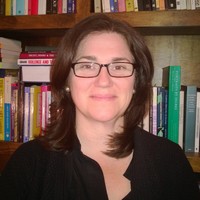
Meet Dr. Isabelle Loring Wallace
Associate Professor of Art History
Associate Director for Graduate Studies, Research, and Recruitment
When did you start teaching in the WIP?
ILW: I’m not sure the precise semester, but it wasn’t long after I began at UGA in Fall of 2004.
What WIP courses are you teaching/have you taught?
ILW: I prefer to teach all my 4000/6000-level courses as WIPs. Courses taught at this level are small (20 or so students) with focused, difficult topics such as: Postmodern Visual Culture, Millennial Culture: Art and Society in the Year 2000, Art Since 1985.
Why did you join the WIP?
ILW: There was no reason not to! The courses I teach under the auspices of the WIP program are courses I designed to be writing intensive, and as such I teach them as writing intensive classes, whether or not I happen to be participating in the WIP program. As I see it, certain material is best taught in conjunction with writing — both because writing allows you to exercise certain intellectual skills not engaged by tests and because these kinds of theory-heavy courses often introduce students to a new language, which writing allows them to practice and gradually assimilate.
What have you learned from your experiences as WIP faculty? About teaching? About writing? About your students?
ILW: Writing is absolutely the best way to master conceptual and/or theoretical material. And, the best way to master writing and several discipline specific skills required by art history is by seeing an assignment through at least one, but ideally several drafts. Students find it empowering to develop their voices and feel the persuasiveness and impact of their words. In turn, I find their success in this enormously rewarding, in that they have acquired skills that can be applied both within and beyond the discipline of Art History.
What is your WIP teaching philosophy?
ILW: I’m not sure if this counts as a philosophy, but what I try to convey to my students in WIP classes is that form and content are inextricable from one another, that what they say cannot be divorced from the means by which they say it.
How do you put that philosophy into practice in the classroom?
ILW: I require drafts of all assignments and grade final papers with an eye to how well students incorporated feedback from their first efforts.
What are your biggest challenges you face as a WIP teacher/in your WIP courses?
ILW: Striking a balance between teaching writing and teaching whatever I’m teaching! Also, making sure that content not directly tied to a writing assignment receives adequate attention from my students.
How do you address those challenges?
ILW: As much as possible, I try to make the writing exercises integral to the course’s progression, so that doing the assignment is the way in which certain ideas are discovered and developed.
What do you hope students take away from your WIP courses?
ILW: The satisfaction of writing well, which is essentially the satisfaction of making oneself heard.
Why is it important that students write in your class?
ILW: Again, writing is the very best way of engaging the material I teach and learning to apply it effectively. Also, more generally, art history is (by definition) the translation of image into word, and, as such, one can say that one is “doing art history” only to the extent that one is engaging in the descriptive, persuasive process of writing.